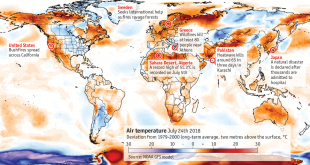SODANKYLA, a town in Finnish Lapland just north of the Arctic Circle, boasts an average annual temperature a little below freezing. Residents eagerly await the brief spell in July when the region enjoys something akin to summer. This year they may have wished for a bit less of it. On July 18th thermometers showed 32.1°C (89.8°F), which is 12°C warmer than typical for the month and the highest since records began in 1908. But Sodankyla is not the only place …
Read More »Science & Technology
The rise of the robochef
CREATOR, a new hamburger joint in San Francisco, claims to deliver a burger worth $18 for $6—in other words, to provide the quality associated with posh restaurants at a fast-food price. The substance behind this claim is that its chef-de-cuisine is a robot. Until recently, catering robots have been gimmicks. “Flippy”, a robotic arm that flipped burgers for the entertainment of customers at CaliBurger in Pasadena, near Los Angeles, earlier this year is a prime example. But Flippy could perform …
Read More »The way people walk can be used for ID and health checks
LISTEN carefully to the footsteps in the family home, especially if it has wooden floors unmuffled by carpets, and you can probably work out who it is that is walking about. The features most commonly used to identify people are faces, voices, finger prints and retinal scans. But their “behavioural biometrics”, such as the way they walk, are also giveaways. Researchers have, for several years, used video cameras and computers to analyse people’s gaits, and are now quite good at …
Read More »How to fool infrared vision gear into thinking you are not there
ANIMALS have made use of camouflage to hide from one another for almost as long as eyes have been around to spot them. Humans, being copycats, have made extensive use of camouflage tricks they have seen in nature by applying concealing colouration to everything from clothing to tanks. A way to thwart camouflage, though, is to employ infrared-viewing technology to look for the heat emitted by an otherwise-camouflaged object. Designing something that can prevent this, and can thus carry camouflage …
Read More »Mixed surgical teams lead to less medical error
SURGEONS are people, and people are animals, and animals often fight. Which is why Frans de Waal, one of the world’s leading experts on animal behaviour, has turned his attention to the operating theatre to demonstrate how insights drawn from his discipline might improve surgical practice. Dr de Waal—and, more particularly, Laura Jones, his colleague at Emory University in Atlanta, Georgia, who did the actual field work—used the methods he honed studying chimpanzees to construct an ethogram of surgical teams. …
Read More »A new species of gibbon is found in a 2,200-year-old tomb
ROYAL burials are just not what they used to be. While still a child, Qin Shihuang, who founded the Qin dynasty and unified China in 221BC, ordered a mausoleum built for himself that would measure 6.3km across at its widest point and include over 8,000 terracotta figures. His grandmother, Lady Xia, was also buried with several companions. When her tomb near Xi’an was excavated in 2004, archaeologists found in it the remains of a leopard, a lynx, a crane and …
Read More »Computer algorithms can test the dodginess of published results
IN AN ideal world the data on which a scientific study is based should be, if not publicly available, then at least available to other researchers with a legitimate interest in asking. Sadly, this is not always the case. Though attitudes are changing, many scientists are still quite proprietorial about their data. They collected them, they reason, and thus they own them, and with them the right to analyse them without sharing them with rivals. This attitude, though selfish, is …
Read More »The Cambrian explosion was caused by a lack of oxygen, not an abundance
DURING the Cambrian period, which began 541m years ago, animal life took a remarkable leap forward. The first creatures believed by most (though not all) palaeontologists to be multicellular animals appear in the previous geological period, the Ediacaran. But though they are abundant and reasonably diverse, Ediacaran creatures do not look ancestral to modern animals. That is in contradistinction to Cambrian fossils, among which are found representatives of all the main animal groups (annelids, arthropods, brachiopods, chordates, cnidarians, echinoderms, molluscs …
Read More »A rocket that devours itself
IT TAKES a lot of oomph to launch a satellite into space. Typically, the payload represents only about 5% of the mass of a rocket as it leaves the launch pad. The rocket’s motors account for some of the rest, but the bulk of it consists of the propellants (the fuel and oxidant that react to produce the thrust required to reach orbit) and the gubbins needed to handle these propellants (tanks, pumps, valves, piping and the bodywork that contains …
Read More »How stress echoes down the generations
THE effects of child abuse can last a lifetime. Neglected or abused children have a higher risk of developing all sorts of ailments as adults, including mental illnesses such as depression but also physical ones like cancer and stroke. In fact, the effects may last even longer. Emerging evidence suggests that the consequences of mistreatment in childhood may persist down the generations, affecting a victim’s children or grand-children, even if they have experienced no abuse themselves. Exactly how this happens …
Read More »








